Container roses are a popular and gorgeous addition to your garden. They’re garden plants, they’re décor … and they smell amazing. Compared to the old, fussy hybrid tea roses that grandma used to grow, container roses are also pretty carefree. Read on to learn how to grow roses in containers.
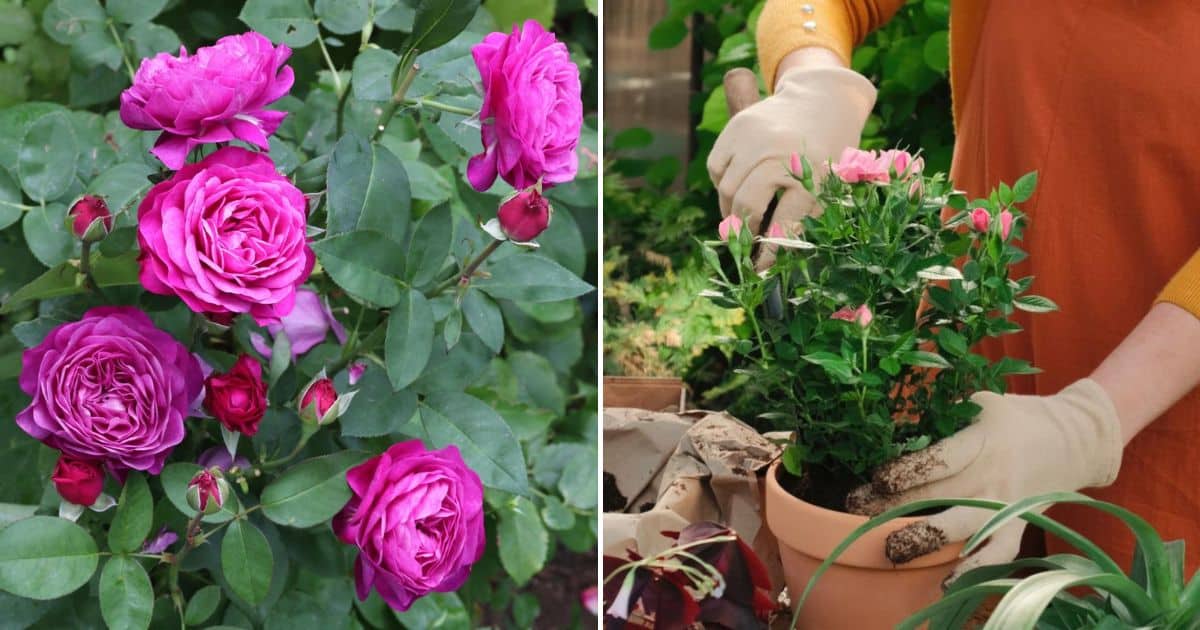
Jump to:
The Benefits of Planting Roses in Containers
- It’s easy to rearrange container roses to get the look you want.
- They’re great in areas with poor soil that won’t support roses.
- Containers can be placed at the right height if you have mobility issues.
- Container gardening maximizes space in small yards.
- The pots and containers add more color and elegance to the garden.
A Few Challenges to Growing Container Roses
- Containers will need to be watered more often, especially when it’s hot and dry.
- Nutrients in the soil will need to be replenished more often.
- Roses grown in containers might not reach their full size.
- But what is life without a few challenges, right?
Planting Roses in Containers
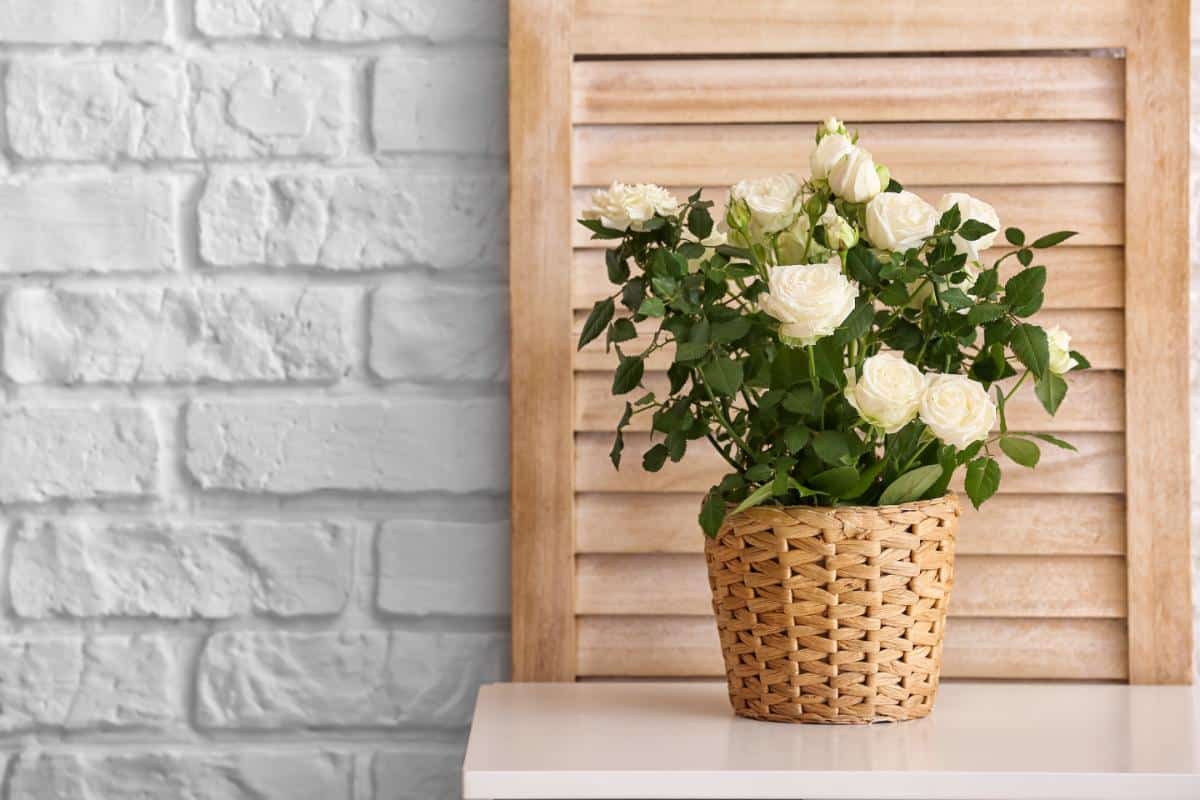
Follow these steps for best results and healthy, good-looking roses.
Choose the Right Container
Choose a decorative container in a beautiful color that really compliments the rose blossoms. Make sure the container has drainage holes large enough for water to easily drain through.
Roses being roses, they prefer a large pot, one that’s at least 15 to 20 inches wide and deep. Ideally, the larger, the better.
If you’re not sure how big your container should be for your plant, get one that’s five inches larger in diameter than the original pot to give your rose room to stretch out its roots. A mature rootball on a rose can be surprisingly large, so choose your pots accordingly.
When to Plant Container Roses

Any time after the last frost is fine. Don’t plant a rose, whether bare-root or potted, when the ground is frozen, or waterlogged, or during a period of drought.
Choose the Right Place for the Potted Roses
Roses need at least 7 hours of light daily to produce good blossoms. In hotter climates where temperatures stay above 95 degrees for long stretches of time, container roses will appreciate some shade between noon to 4 pm.
If the container is large, place it where you want it BEFORE filling it with potting soil.
Prepare the Container for Planting
Create good drainage in the pot by putting a layer of rocks or pumice at the bottom. Heavy, large containers can be made lighter by using aluminum cans instead of rocks.
No matter how good the soil in your garden is, it won’t work in a pot. Garden soil and bagged topsoil used alone in a pot become as hard as a brick.
However, compost works great, along with well-rotted barnyard manure – that is, manure that’s been broken down so it looks and smells like soil.
The folks at David Austin roses use straight compost in their rose pots, while I prefer to mix in potting medium that contains ingredients like vermiculite, peat, coco coir, perlite, and horticultural charcoal. This makes potting medium easy to handle and springy. It also allows oxygen to reach the roots without drying them out, and allows water to drain easily.
Plant the Rose at the Right Height
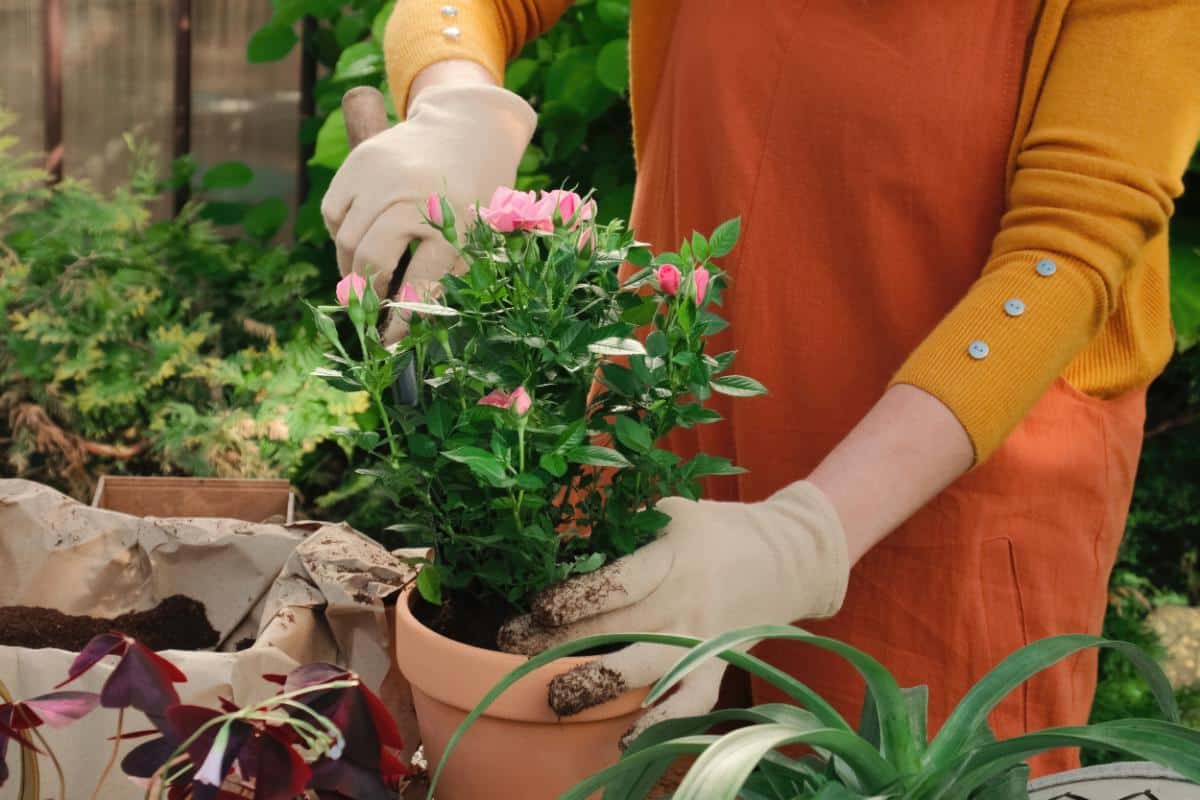
Add a good quality potting mix to partially fill the pot, lightly pressing it down. Occasionally, set your potted rose into the pot and see where the bud union (if the rose has one) or the stem of the rose sits in relation to the edge of the container. A bud union is a swollen knob on the neck of a rose that has been grafted onto a hardy rootstock and should be planted a couple of inches underground for container roses. A rose with no bud union is growing on its own roots, and the neck of these can sit at ground level and be fine.
Once your rose is at the right level, set the potted rose on its side on the edge of the pot and slide out the rootball. If the rose doesn’t budge, tap or slightly squeeze the sides and try again. Then, set the rose rootball in the middle of the pot and pile the rest of the potting mix around it.
Water the soil well so it’s drenched. Watering also makes the air bubbles in the soil collapse, so add extra compost/potting medium and water that in.
Add Other Plants for Color
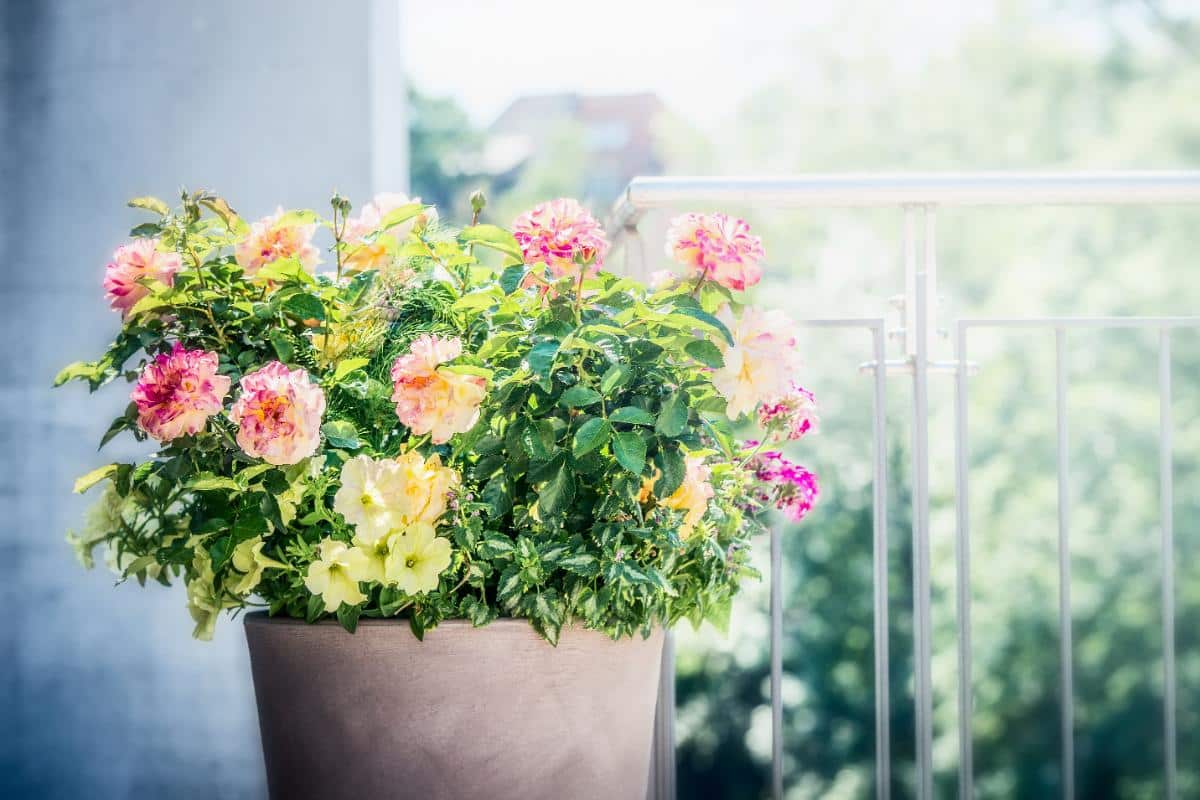
A few plants can be added to the container around the rosebush, but be sure to give both plants and roses enough space to grow. That cute plant in the 4-inch container won’t stay small forever – so choose plants that aren’t aggressive to avoid plant drama later on.
- Shallow-rooted annuals that work well with roses include sweet alyssum, lobelia, and sedum (available in all kinds of colors and shapes).
- Marigolds are good for repelling some pests – be sure to choose the smaller varieties.
- Annual geraniums look lovely and also contain a chemical that stuns Japanese beetles, leaving the pests lying on their backs among the geranium leaves.
- Perennials like dianthus, creeping thyme, and coreopsis won’t take over the rose container and are light feeders, which allows the hungry roses to take the bulk of the nutrition.
Cultural Needs for Container Roses
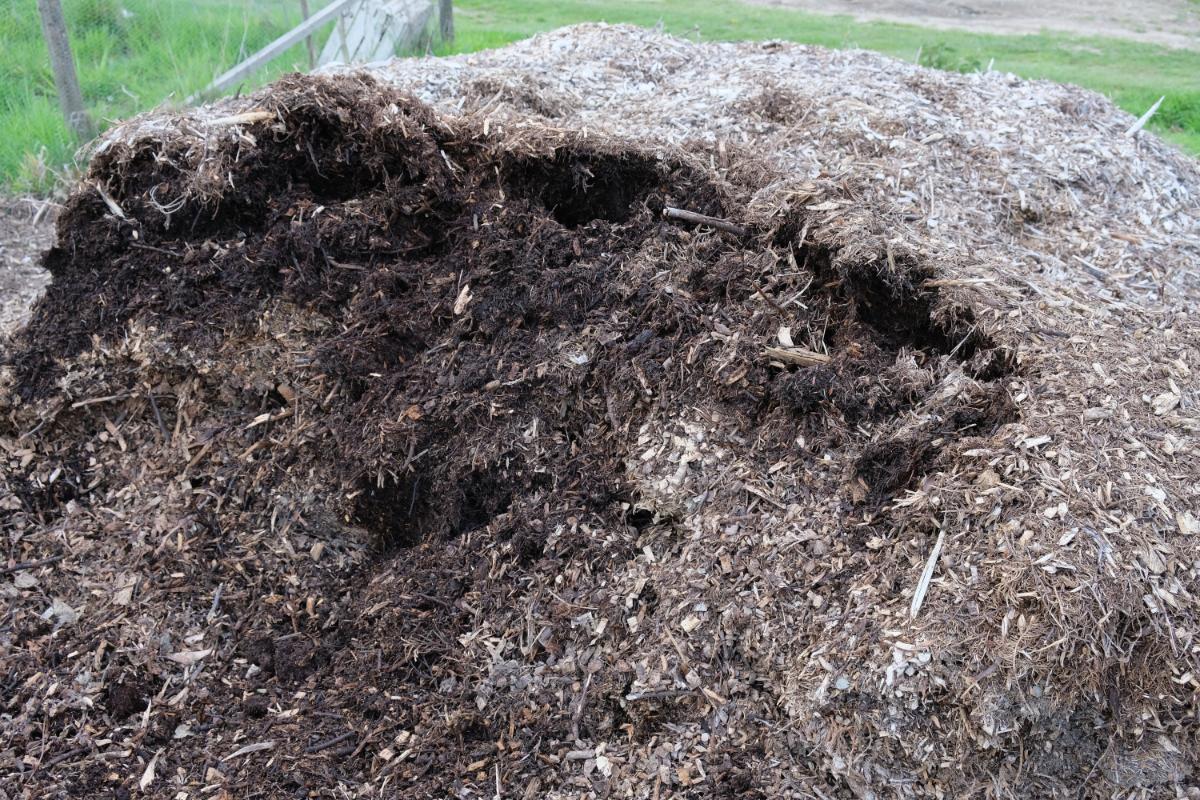
Help your potted roses survive whatever nature throws at them with these helpful tips!
Mulching Container Roses
Adding mulch to containers is something that should be more widely done, especially in areas with hot, dry summers.
Mulch is an effective insulator. Add a layer of mulch to the pot to hold moisture in, to keep roots cool in the summer sun, and to keep weeds from popping up in the potting soil.
Some of my gardening buddies have complained about how much I talk about mulch, and if I could, I’d be driving a big front-loader up to their house with a bucketful of mulch saying, “I HIGHLY ENCOURAGE YOU TO USE THIS.” When they add mulch around their roses and see their sad roses sit up and start putting out leaves, they, too, see the light.
Moving Large Potted Roses
Protip: To make the best of your locations, put your large plant pots on wheeled caddies so you can roll them from place to place.
If you choose not to move your container roses, they will sometimes send roots through the drainage holes into the ground and can become permanent fixtures.
Watch Out for Wind
If you get severe summer storms or have winds that come sweeping down the plain, take this into consideration when you’re choosing pots and plants. Use shorter or heavier containers so strong winds don’t topple the pots like dominoes.
Wind will dry out your roses and containers, especially when it’s hot. Lay a thick mulch over the soil in your pots to help slow evaporation and to protect the soil from drying out too quickly.
Watering Roses
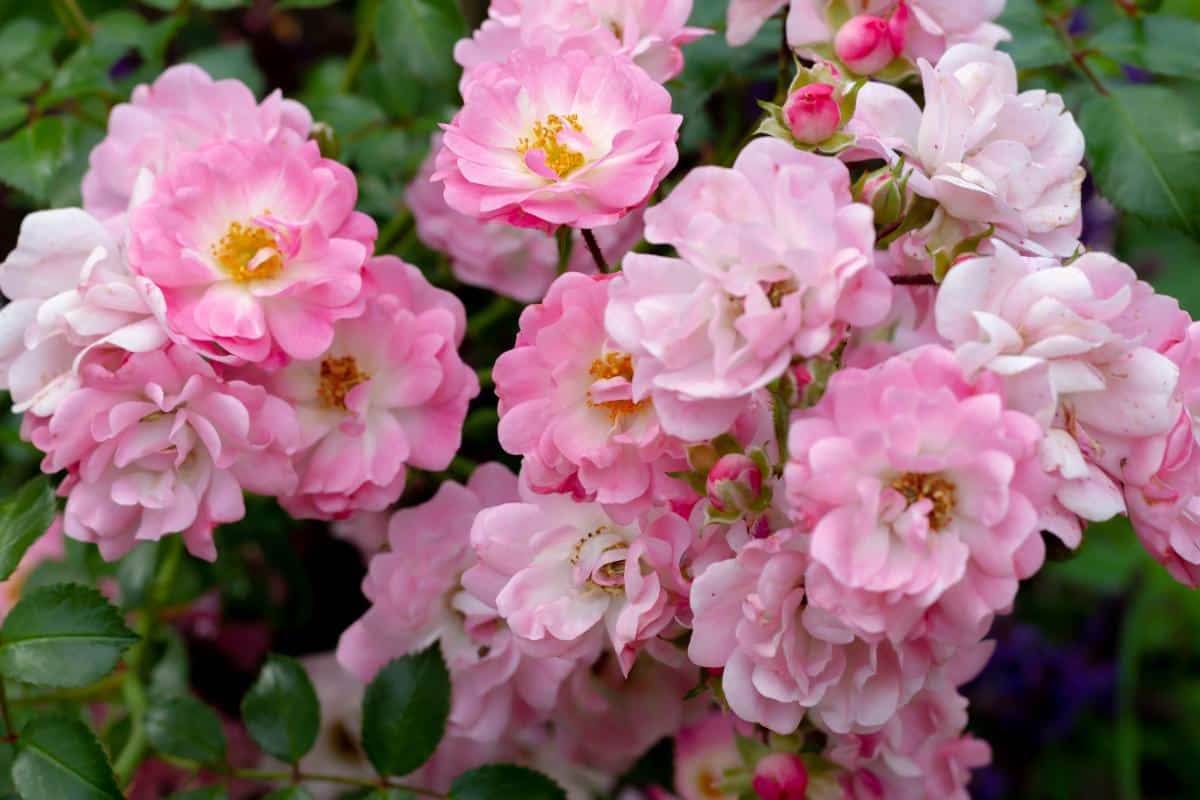
Again – and this is important – make sure your containers have sufficient drainage. If a pot isn’t draining, your plants will get root rot. If you suspect that your container is filling up with water, carefully tip it over and see if anything pours out. Have the hose handy to wash the poured-out water away because its putrid smell will knock your socks off. Then, find a way to add drainage or put the rose in a pot that actually drains!
In the summer, you might have to water once or even twice a day. Use a hose with a sprinkler wand to create a gentle spray of water that will not knock the soil out of the pot.
Burning Hot Summers
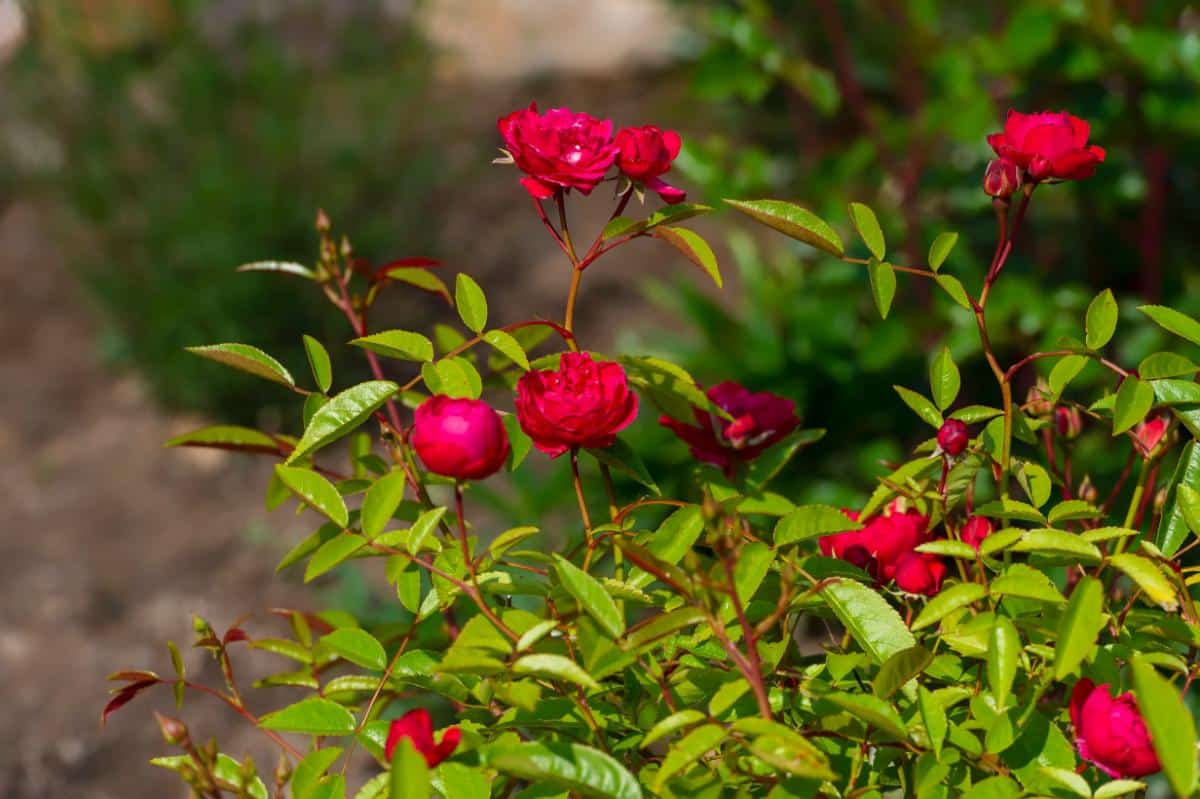
If you’re in a hot climate and your container roses look peaked, move them to a place where they can get a little shade during the hottest parts of the afternoon. Also, in hot climates, avoid using metal or dark-colored containers that will collect the heat of the sun and bake the plant roots.
One way to keep pots and roots cool when the heat is brutal: Double-pot your pots. Slip a smaller pot into a larger one, then pack wet sphagnum moss or newspaper between them. Every time you water your plants, water the filler as well. This will help keep the roots from cooking.
Also, they should be moved away from heat accumulators like walls, sidewalks, and parking lots, which only intensify the heat.
Freezing Cold Winters
Cold-climate dwellers have the opposite problem: Trying to find a place to put the rose containers in winter. Look for warm microclimates in your yard – say, against the south side of your house – and tuck the container roses in there. Cover the roses with mulch to protect them against freeze/thaw cycles.
An alternative is to wait for the rose to go dormant, then cover it with mulch and bring the rose and container into an unheated garage to wait out the winter. Water it now and then so it doesn’t dry out.
The Best Roses to Grow in Containers
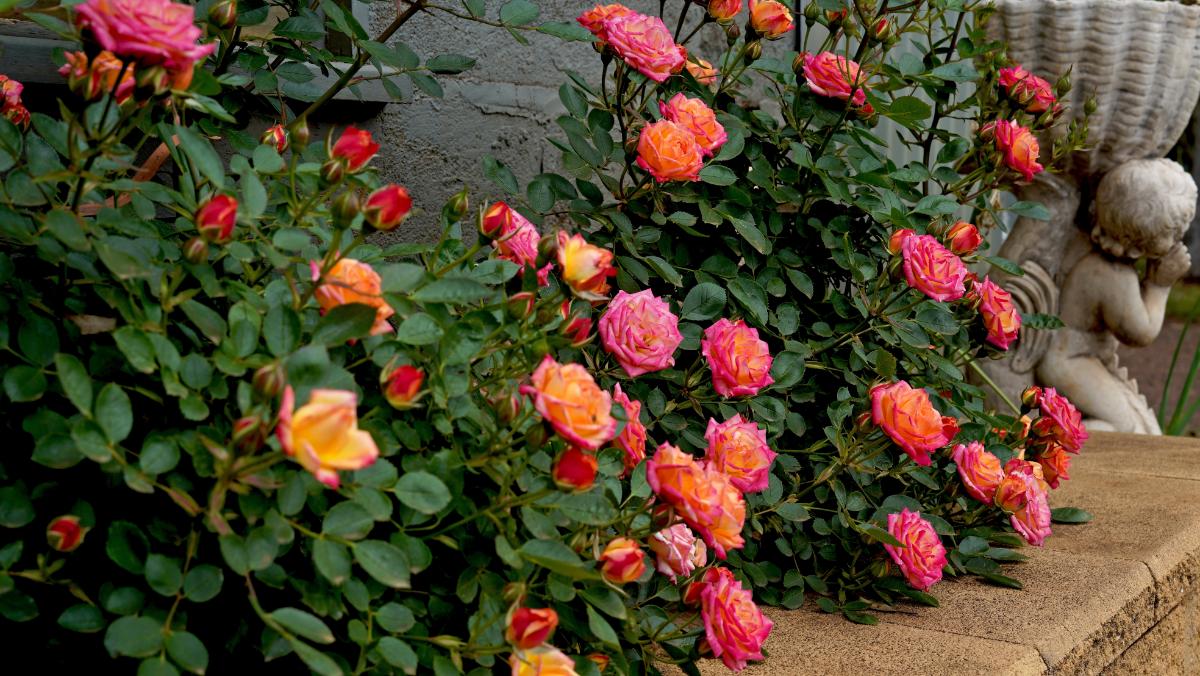
Today’s roses are bred for beauty, but they’re also bred to be grown in the landscape as low-maintenance plants – no spraying required. These container roses are no exception.
Miniature roses
Naturally, miniature roses work great for container growing and will brighten any pot with their exquisite tiny blossoms.
Gourmet Popcorn is a shrublet that covers itself with crisp white blooms. This little rose looks like somebody threw a handful of popcorn over it.
All A-Twitter is a miniature rose in a bright, bold shade of orange. Grows 12 to 16 inches tall.
Sun Sprinkles is covered with adorable, bright yellow flowers.
Groundcover roses
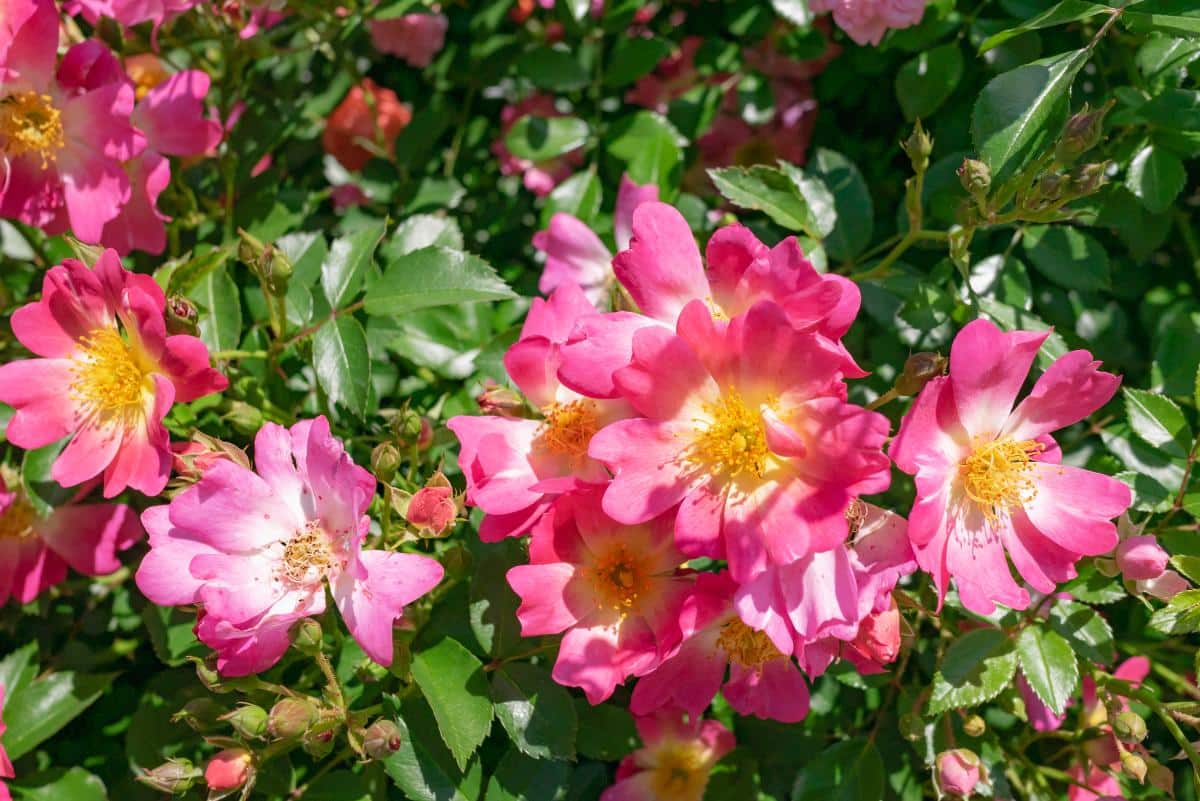
These are low-maintenance, spreading roses that are short – only a foot or two at most – and spread, trailing across the ground and covering themselves with bright blossoms all growing season.
Most groundcover roses will work well in containers.
- The Drift rose collection – available in many colors, including Peach.
- The Carpet rose collection
- White Meidiland groundcover rose covers itself with tons of large, snowy-white blossoms from late spring until frost.
Tree roses
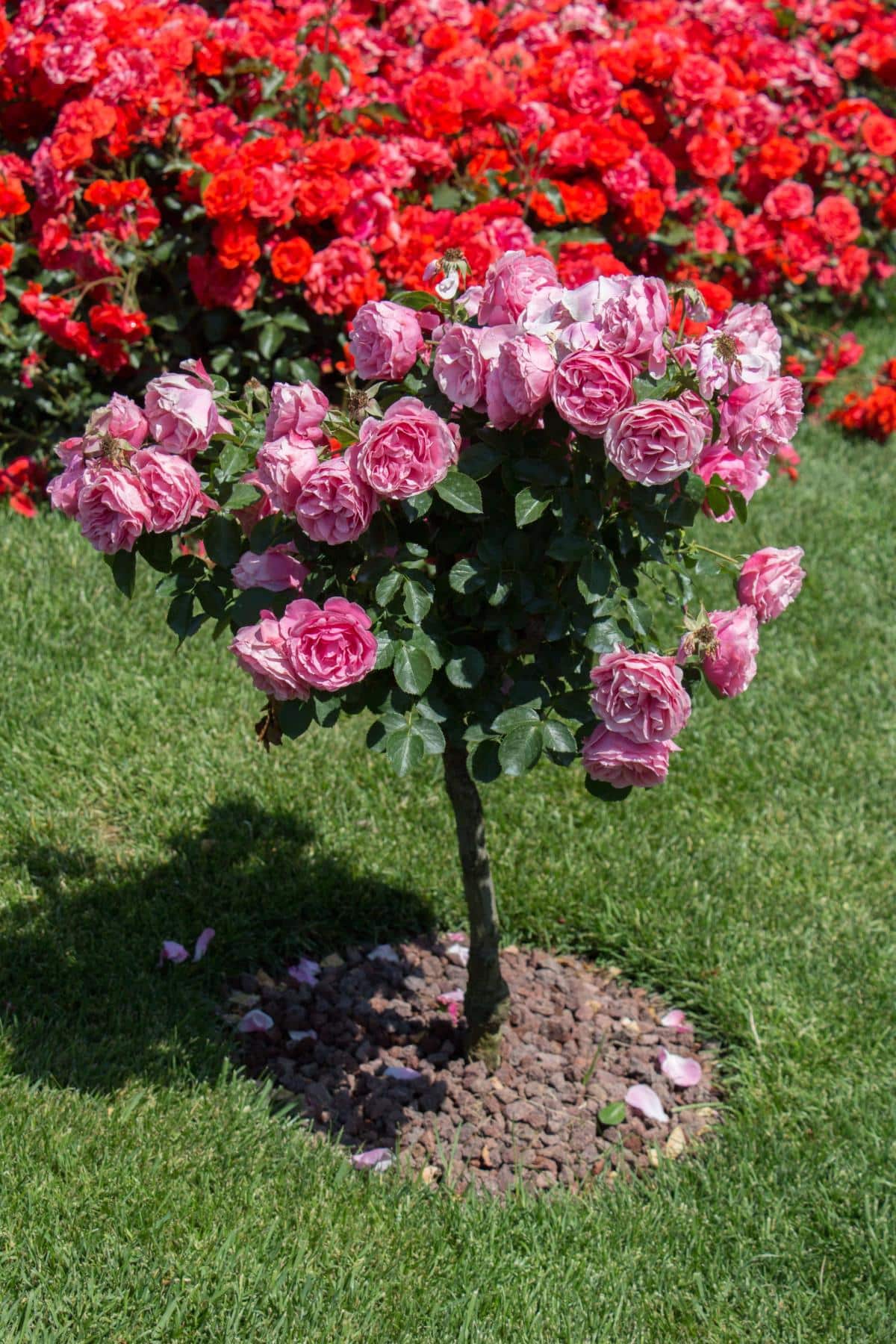
Tree roses, also called grafted standard roses, are created by grafting several rose shrubs onto a tall “trunk” made from a hardy rootstock. It’s basically a rosebush on a stick.
Tree roses are naturals for container garden, and take well to having a variety of flowers growing at their feet. Tree roses will need to be staked for the first few years.
Most tree roses will fit within the confines of a pot and brighten any backyard – so any kind will work.
Patio roses
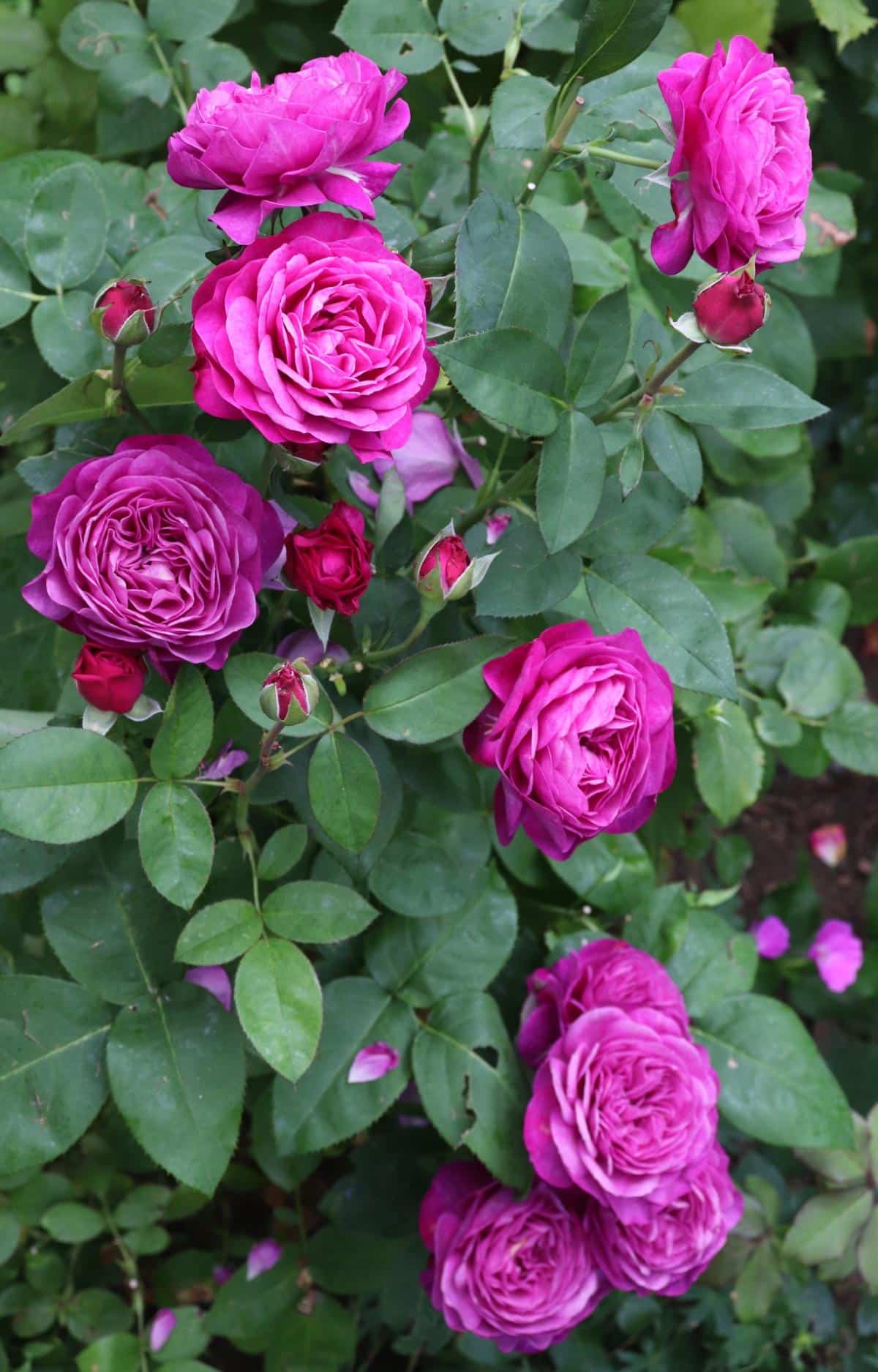
Now, this is a new category for me. Patio roses are a new type of rose bred for containers – often a cross between a floribunda rose and a miniature rose. There are even compact miniature climbers.
- Petite Knock Out rose – The Knock Out roses are disease-resistant wonders, and this chipper miniature is no exception, with little red flowers and glossy green foliage.
- Oso Easy Italian Ice – A tidy shrub only 2.5 feet tall and wide, this pretty rose has flowers with bright yellow centers that fade to cream and then to a peachy pink in the outer petals. Floriferous and fancy. Also available in red.
- Sunblaze Rainbow bears dainty, 1-inch blossoms with bright yellow centers and orange-red outer petals, and the red color grows brighter as the flowers age.
Small shrub roses
If the container’s large enough, then a small shrub rose would be fine growing here.
Grace – An Austin rose, Grace bears fragrant blooms in soft peach and darker orange. Olivia Rose has large, cuplike blossoms in pink and a light fragrance.
Desdemona bears white, strongly fragrant blossoms all season long.
Lady Emma Hamilton is graced with tangerine-orange flowers and rosebuds of dark red and has a lovely fragrance.
Seafoam is an old rose favorite that’s easy to care for and bears lots of white blossoms all season long.

Read more:

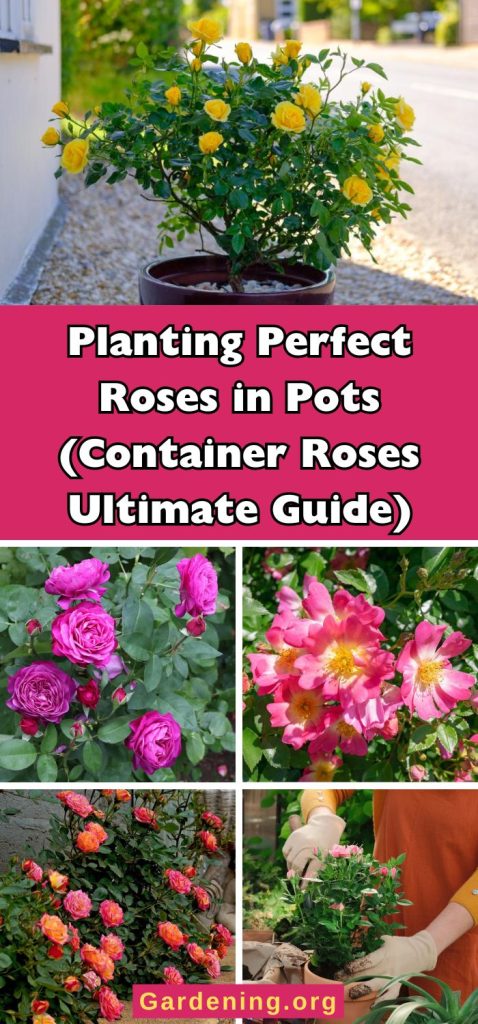
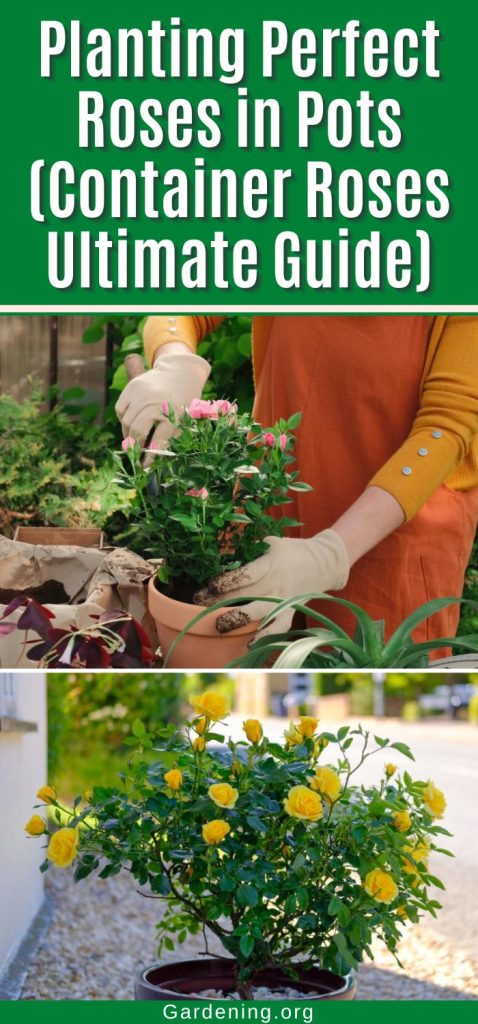
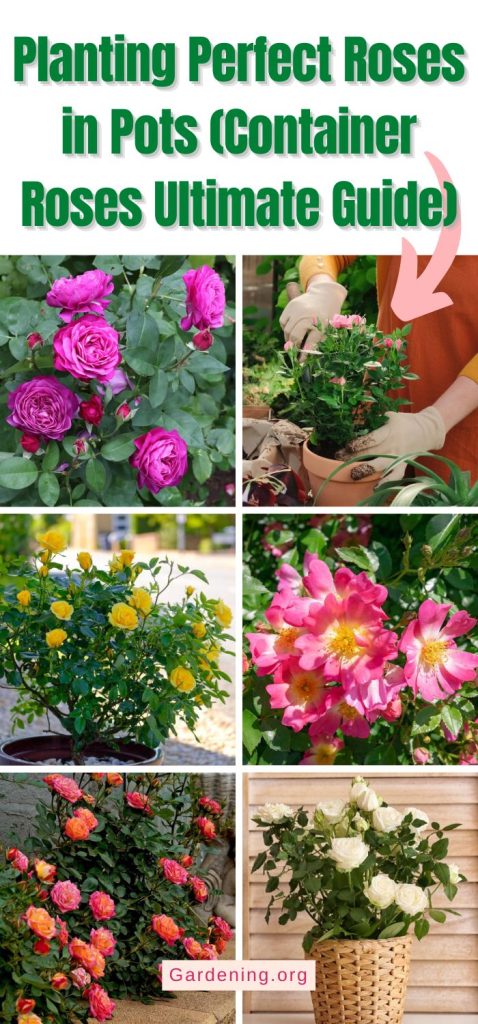
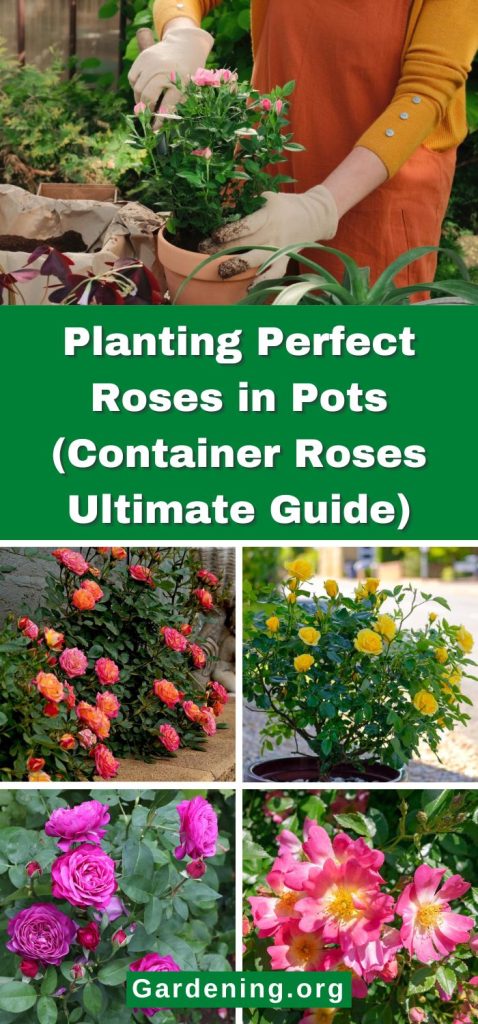
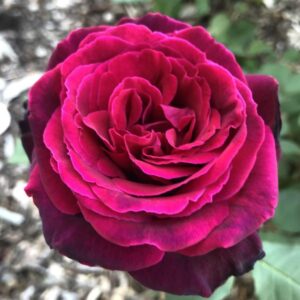



Leave a Reply